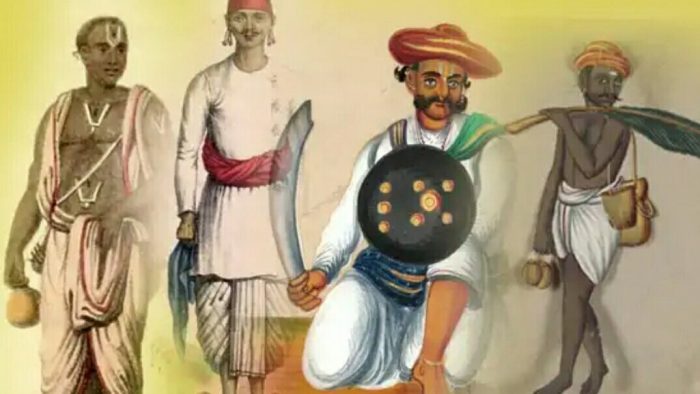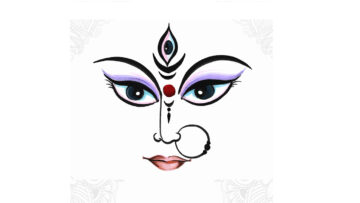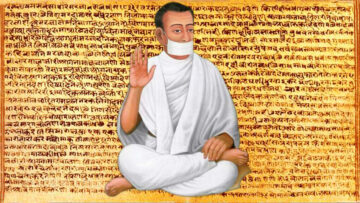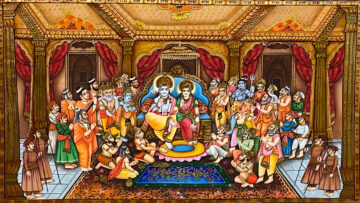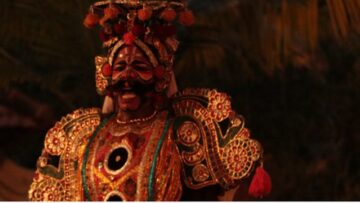Varna Vyavasta in Practice
Till now, the conceptual framework of Varna Vyavasta and its different elements as explained in the Hindu scriptures were discussed. Now let’s look into what Hindu scriptures say about Varna Vyavasta in practice.
Bhagavata Purana, one of the most important Puranas, says that during Satya Yuga, there was just one Varna called Hamsa, and all people perfectly fulfilled their Svadharma (11.17.10). Then, during Treta Yuga, four Varna’s were manifested from various aspects of Supreme Purusha and each Varna was designated by the associated Svadharma (11.17.13).
Even if one were to reject the cosmological aspects of the Yuga cycle, what we understand from above is that originally there was just one Varna (called Hamsa and identical in many ways with Brahmana Varna, i.e. Sattva Guna), and Dharma stood as four legs (11.17.11). Slowly, as time passed and Dharma reduced, one Varna made way for four Varnas that evolved due to the play of the three Gunas.
Now, from Manu Smriti (Chapter 10), we understand, how four Varnas made way for six more Sankara Jatis (groupings of mixed Guna Varna) due to Varna Sankara. And further Varna Sankara leads to even more number of Sankara Jatis having complex Guna Svabhavas.
This is again repeated in Mahabharata (12.188) as well. It says the whole world at first consisted of Brahmana Varna alone, but later as a consequence of their actions, i.e. as a result of a fall from Dharma and Spiritual Truth, they became divided into different Varnas.
Among the Brahmanas, those who made way for passions, courage, desires became Kshatriyas; some others developed attributes for cattle rearing, agriculture, etc. and became Vaishyas; and those who came under the influence of ignorance became Shudras. Thus, separated by the duties and professions driven by desires, Brahmanas themselves, who fell from their Brahmana Svabhava, became members of other Varnas.
From the scriptures, we understand that ‘Janma’ or ‘birth’ into a family was used as an identifying factor to determine the Guna/Svabhava of a person because Svabhava of an individual depends upon Varna (Svabhava) of parents and the Samskaras inherited from previous lives.
Owing to the higher content of Dharma in society (Dharma stood on four, three, and two legs in Satya, Treta, and Dwapara Yuga respectively) and a less complicated and clearly differentiated Svabhava, and very less prevalence of Varna Sankara, Janma into a family was a valid, useful tool to determine Svabhava in the previous Yugas (though exceptions may well be seen even in previous Yugas).
The Varna of the parents, the Varna of the children, the Svadharma practiced by the whole family were all in perfect sync, due to the higher prevalence of Dharma and a less complicated Prarabdha Karma. Hence, during the previous Yugas, ‘Janma into a family’ indeed gave a correct indication of Svabhava that was got from Prarabda Karma. Though, one can note the exceptions to this mentioned throughout Vedic and Puranic literature (Example: Kavasha Ailusha and Mahidasa Aitareya).
But, Kali-Yuga, by its very nature is very low on Dharma. Here, Dharma stands on only one leg and the society is full of Varna Sankara and confusion of Svabhava and Svadharma. Further, the whole system of Varna has been dismantled and replaced by a caste system that has trivialized Varna, Jati, and other indigenous identities.
In such a condition, though, Prarabdha Karma is still the deciding factor behind the Varna an individual inherits, ‘Janma into a family’ has ceased to be a completely fail-safe tool for determining Varna in a majority of the people.
However, it remains a provisional criterion for determining Varna nevertheless and is useful when combined with other factors of Guna and Karma. Also, for ‘Janma into a family’ remains a valid tool to determine Varna regarding families who have continued to practice their Svadharma. For example Vaidika Brahmanas.
That is, a person who is not a Brahmin by name only and but has temperaments towards Brahmana Svadharma and practices Vaidika duties. But otherwise, in a large number of cases, the ‘caste’ name or ‘Jati’ names are unhelpful in determining one’s Varna and we need to bring in Guna and Karma into the equation.
Yet, confusion still remains regarding the connection between Janma and Guna in the determination of Varna. In fact, this confusion can be witnessed as developing during the times of Mahabharata itself.
During the exile of the Pandavas, when Bhima is captured by a serpent, which was cursed to be in that form, the serpent asks Yudhisthira a question regarding who is a Brahmana. Yudhisthira then replies that a Brahmana is one who exhibits various characters like truth, mercy, etc. The serpent says that those characters can be seen in Shudra people as well.
To this, Yudhisthira replies that all those people in whom these qualities are exhibited, they are Brahmanas, and in whom they are not exhibited are all Shudras, even if such a person may have been born into a Brahmana family. He explicitly states that neither Brahmana nor Shudra belongs to a particular Varna simply because they are born into it (i.e. They are born into that family).
He further states that it was very difficult to determine one’s Varna in human society owing to the promiscuous intercourses among all the four Varnas, thus resulting in mixed Varna offsprings. (Mahabharata 3.177).
Thus, it is clear that the usage of ‘Janma into a family’ as the criteria of identifying one’s Svabhava had ceased to be a completely fail-safe tool during the times of Mahabharata itself (yet it continued to be used for a long time even in Kali-yuga). This also explains why Arjun had expressed reservations about fighting the battle at the beginning.
He had expressed his fears about how the battle may ultimately lead to Varna-Sankara, which would, in turn, destroy the whole society. Though Lord Krishna clarifies the confusion of Arjuna, the point of interest is that Arjuna appears to have been aware of the fact that the determination of Varna of a person by ‘Janma into the family’ had already assumed some amount of difficulty during those times and hence he wanted to prevent further complexity and the eventual destruction of Varna Vyavasta.
More importantly, the present society is seriously inflicted with the rigid caste system, its hierarchies, and politics, hence there is no correlation between the Varna designations as given in the scriptures and the same terms used as caste names today.
The present system of caste is a colonial construction by the Christian missionaries and the British government, which distorted the scriptural Varna system of Svadharma and amalgamated it with various indigenous social groupings like ethnocultural Jatis, skill groups- kulas, etc. and created a racial classification of ‘Caste’ based on European racial ‘Casta’ classification system.
As a result, it will be a folly to use the ‘janma into a family having a particular caste name’ as a sole factor for determining any person’s Varna.
Further, owing to the challenges of modern society, it is very difficult to determine the Varna of a person purely on the basis of duties and professions one is involved in as well. A person performing duties of a Brahmana may well have Guna of other Varnas or of Sankara Jatis and this is true regarding the duties of other Varnas as well.
Therefore, in the present age, neither Janma into a family alone, nor observable actions and professions alone are fail-safe methodologies to determine the Varna of a person (though, they may still be applicable as stand-alone factors in some cases, or as secondary factors in some other cases). As a result, it is up to each individual to recognize his/her Varna by analyzing his/her own inner temperaments and inner callings and performing Svadharma accordingly.
Varna Sankara and Jati
At this juncture, it is important to point out that the terms ‘Jati’ and ‘Varna Sankara’ are often misunderstood. The term ‘Jati’ in the scriptures like Manu Smriti is mostly used as synonymous of Varna (i.e. Svabhava) or as a designation for people having temperaments derived from more than one Varna and hence cannot be classified into any one of the four Varnas.
Also, the association of various professions with various Sankara Jatis that are available in Manu Smriti is neither completely prescriptive nor completely descriptive. Instead, they are merely indicative examples used to correlate between Svabhavas of Sankara Jatis and probable professions that they may adapt accordingly.
It was only at a later time that the term ‘Jati’ began to be used for referring to a large range of ethnocultural groups and at times got overlapped with clans and skill groups (Kulas). But, in Manu Smriti itself, it is used only to denote Svabhava.
Now coming to the term ‘Varna Sankara’, it is often translated as mixing of castes through inter-caste marriage. But, this understanding is not fully correct in the current context owing to the fact that ‘caste’ as we understand today, is quite different from the concept of Varna or Jati present in Hindu scriptures. Thus, Varna-Sankara does not happen per se due to inter-caste or inter-ethnic, or inter-profession marriages.
Instead, Varna-Sankara is caused by a number of factors, of which inter-Varna marriage is just one of them. Inter-Varna marriage simply refers to marriage between people having different Svabhavas, and hence different Svadharmas. In other words, it refers to marriage between two incompatible people, who have different desires, temperaments, and life goals.
Such, incompatible marriages cause Varna-Sankara because, children born of such marriages inherent qualities and temperaments from both their parents and hence, will have a Svabhava that would partially reflect the different Svabhava’s of both the parents.
As a result, such children cannot be classified into any of the four Varnas and assigned respective Svadharma. Such children born out of Varna Sankara, are considered either as Shudra or as Avarna (depending on their Svabhava), owing to their lack of all temperaments required to perform Svadharma of the Trivarna (Brahmana, Kshatriya, Vaishya) or Chaturvarna, respectively.
Other reasons for Varna Sankara, as listed by Manu (10.24) are: Adultery (we may include prostitution as well), marriage within Gotra i.e. incest, abandonment of one’s own Svadharma. Therefore, we can clearly see that Varna Sankara does not necessarily refer to endogamy nor can we classify every case of endogamy as Varna Sankara. It instead refers to children being born with mixed Varna i.e. having a mixed pool of temperaments that have been derived from multiple Varnas. And such a condition may arise out of multiple causes.
Irrespective of the cause, Varna Sankara results in the inability of the Sankara Jatis (people born out of Sankara) to perform any of the four main Varna Svadharma, owing to lack of qualifications and temperaments required to perform them. It is for this reason alone that Hindu scriptures speak against Varna Sankara.
Thus, on the one hand, Varna Sankara presents a practical difficulty in the identification of the correct Svabhava of an individual and hence complicates the process of assignment of proper duties to him/her. On the other hand, an increase in Varna Sankara translates into a decrease in the number of people with Trivarna Guna available to perform the Trivarna Svadharma, which in turn leads to various kinds of chaos and disorder in the society.
Also, further mixing of Varnas among the Sankara Jatis, i.e. people with different Sankara Svabhavas leads to children with more complicated Svabhavas, which further complicates the identification and assignment of the Svadharmas and will ultimately result in the collapse of the practical Varna Vyavasta model that used ‘birth in a family’ as a factor for identifying the Svabhava of an individual.
Conclusion
The caste system has been used for long for criticizing Hinduism as being oppressive and discriminatory by equating it with the scriptural concept of Varna. Yet, a thorough reading of Hindu scriptures reveals that there is no religious basis for the caste system and discrimination and the scriptural conception of Varna Vyavasta has no correlation with the present form of the caste system.
Hinduism conceives a world wherein each person will be able to attain material happiness and spiritual bliss. And this is only possible when people are able to fulfill their desires and fulfill them in such a way that there is no infringement on other’s freedom and they are slowly able to transcend those desires. Towards this end, the pursuit of happiness and desires, the actions committed in this pursuit have been stringed to the righteous duties.
Thus, each person has a Svadharma- personal duties or purposes in life that help them to travel towards the ultimate goal of Moksha (liberation). And to facilitate each person to choose his Svadharma, based on his temperaments, behavior, and the inherent nature (Svabhava), the system of Varna or Varna Vyavasta has been conceived by the Hindu scriptures.
Thus, Varna classification is a conceptual classification based on Svabhava of individuals and aimed at facilitating the practice of Svadharma, and has no direct correlation to the artificially constructed social stratification factors of race, caste, or ethnicity.
Reference:
- Adi Shankaracharya, Vivekachudamani Verse 2
- Amrita-Bindu Upanishad, Verse 1-2
- Amrita-Bindu Upanishad, Verse 3-4, Isha Upanishad Verse 11
- Srinivasa Rao, Sadharana Dharma- the Indian doctrine of Universal Human Duties. National Seminar on Dharma, Virtue, and Morality: the Indian Ideal of Human Perfection (2005, Kanpur, India). Compiled in a book: Dharma and Ethics, Edited by D.C. Srivastava and Bijoy H. Boruah
- Manu Smriti 10.63
This Series was first published on India Facts.
Disclaimer: The opinions expressed in this article belong to the author. Indic Today is neither responsible nor liable for the accuracy, completeness, suitability, or validity of any information in the article.

